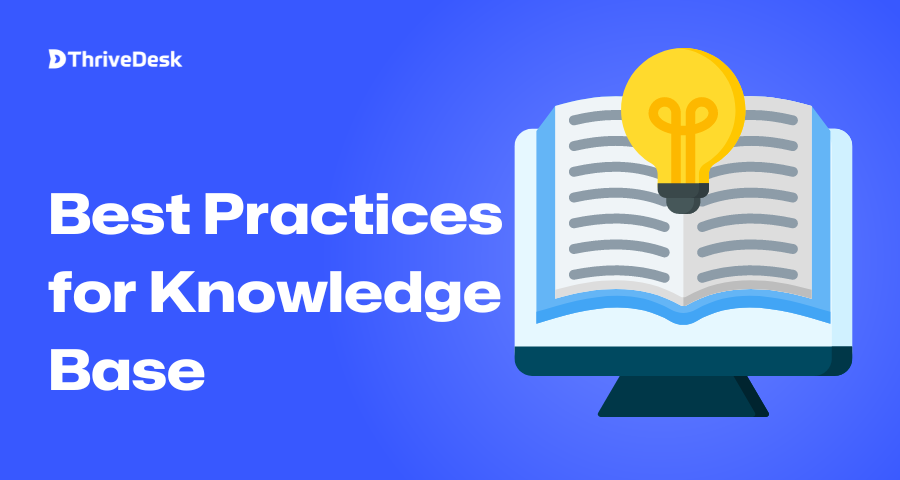A knowledge base acts as a central information repository, offering a self-service solution to common questions and issues. By meeting users’ needs effectively, a well-crafted knowledge base can greatly enhance customer satisfaction, lower support expenses, and boost overall efficiency.
The significance of having a comprehensive and user-friendly knowledge base is immense. When properly implemented, it enables users to find answers independently, decreasing the dependence on support staff and promoting a sense of self-reliance.
However, developing an effective knowledge base demands meticulous planning, strategic content creation, and a dedication to ongoing refinement.
In this piece, we’ll delve into ten best practices for knowledge base designing, building, and maintaining. These practices genuinely benefit your audience.
We will cover setting clear objectives and understanding your users. We’ll also discuss optimizing content for easy navigation and incorporating multimedia.
By following these strategies, you can ensure your knowledge base is a standout resource.
What is a Knowledge Base?
A knowledge base is a centralized repository of information that provides self-service solutions to common questions and problems. It helps users find answers quickly and independently, improving customer satisfaction and reducing the need for support staff.
Typically, a knowledge base includes FAQs, troubleshooting guides, how-to articles, and other resources tailored to meet the specific needs of its users. It is designed to be easily searchable and accessible, allowing users to efficiently locate the information they require without external assistance.
10 Best Practices for Knowledge Base
1. Know Your Audience & Goals

Before embarking on the journey of building a knowledge base, it’s crucial to clearly define your target audience and set specific goals for your knowledge base. This foundational step will shape the content, structure, and overall user experience, ensuring that your knowledge base effectively meets the needs of its intended users.
Identify Your Target Audience
Your knowledge base can serve various user groups, such as customers, employees, partners, or a combination of these. Understand the unique needs, backgrounds, and technical proficiencies of each group to tailor the content and language accordingly.
For instance, a customer-facing knowledge base may require simpler language and more visual aids, while an internal knowledge base for employees could delve deeper into technical details.
ThriveDesk’s private and public help center options allow you to create targeted documentation that can be accessed by specific groups, ensuring that sensitive information remains secure.
Set Clear Goals
Establish well-defined goals for your knowledge base to measure its success and align your efforts. Common goals may include reducing support ticket volumes, improving customer satisfaction rates, streamlining employee onboarding processes, or increasing product adoption rates. By setting specific, measurable, achievable, relevant, and time-bound (SMART) goals, you can track progress and make data-driven decisions to continuously enhance your knowledge base.
Aligning your knowledge base with the needs of your audience and organizational objectives is the foundation for creating a valuable resource that drives tangible results. By keeping your users and goals at the forefront, you’ll be better equipped to deliver a knowledge base that truly resonates with its intended audience.
2. Structure for Clarity

A well-organized structure is vital for ensuring that your knowledge base is easy to navigate and information is readily accessible. Clear categorization and intuitive layout can significantly enhance the user experience, reducing frustration and increasing the likelihood of users finding the answers they need.
Implement a Logical Hierarchy
Organize your knowledge base content into a logical hierarchy, starting with broad categories and drilling down into subcategories and specific articles.
This nested structure allows users to quickly identify relevant sections and navigate to the desired information effortlessly. Consider mirroring the structure to your product or service offerings, making it more intuitive for users.
ThriveDesk supports nested categories with drag-and-drop ordering, allowing you to create a clear and intuitive structure.
Utilize Categories and Subcategories
Divide your content into well-defined categories and subcategories that reflect common topics, features, or use cases.
For example, ThriveDesk’s category and child category features help you organize articles so users can easily browse and find the information they need. A software knowledge base could have categories like “Getting Started,” “Features,” “Troubleshooting,” and “Integrations,” with each category further subdivided into specific subcategories.
Leverage Tags and Filters
Implement a robust tagging system that allows users to filter content based on relevant attributes, such as product versions, platforms, or user roles. This enhanced filtering capability enables users to quickly narrow down their search and find the most pertinent information.
Maintain Consistent Naming Conventions
Establish clear naming conventions for categories, subcategories, and article titles, ensuring consistency throughout the knowledge base. Consistent naming not only enhances the overall user experience but also facilitates better search engine optimization (SEO) and discoverability.
By investing time and effort into crafting a clear and intuitive structure, you’ll empower users to effortlessly navigate your knowledge base, leading to higher satisfaction rates and a more efficient self-service experience.
3. Craft User-Friendly Content

While a well-structured knowledge base is essential, the quality of the content itself is paramount. User-friendly, easily comprehensible articles are key to ensuring that your knowledge base truly resonates with its audience and effectively addresses their queries and concerns.
Write Informative and Concise Articles
Strive to create content that is both informative and concise, striking the right balance between providing comprehensive information and maintaining readability.
Avoid unnecessarily lengthy explanations or irrelevant details that may confuse or overwhelm the reader.
ThriveDesk’s next-generation block-style editor makes it easy to create and edit content that is both informative and concise.
Employ Clear and Descriptive Titles
Craft attention-grabbing and descriptive titles that accurately reflect the content of each article. Well-written titles not only help users quickly identify relevant information but also improve search engine optimization (SEO) and content discoverability.
Utilize Headings, Bullet Points, and White Space
Break down lengthy articles into easily digestible sections using clear headings and subheadings. Incorporate bullet points and lists to highlight key information, and leverage white space to improve readability and prevent overwhelming the reader with dense blocks of text.
Maintain a Consistent Voice and Tone
Establish a consistent voice and tone throughout your knowledge base that aligns with your brand’s personality and resonates with your target audience. Whether you opt for a formal or more conversational style, maintaining consistency helps build trust and enhances the overall user experience.
By crafting user-friendly content that is easy to comprehend and navigate, you’ll ensure that your knowledge base truly serves as a valuable resource, empowering users to find the information they need quickly and efficiently.
ThriveDesk’s collaborative features allow multiple team members to contribute while maintaining a consistent style.
4. Prioritize Powerful Search

In a vast knowledge base, a robust and intelligent search function is crucial for enabling users to quickly find the information they need. A powerful search capability not only enhances the overall user experience but also directly impacts the effectiveness and usefulness of your knowledge base.
Implement Advanced Search Features
Leveraging advanced search features can dramatically enhance user experience by providing quick and accurate results.
For example, ThriveDesk’s Knowledge Base offers device-optimized and user-friendly advanced search functionality, ensuring users can find what they need effortlessly. This feature can significantly boost productivity and user satisfaction by reducing the time spent searching for information.
Leverage Autocomplete and Suggested Searches
Incorporate autocomplete functionality and suggested search terms to aid users in refining their queries. This feature not only saves time but also helps users discover relevant articles or topics they may not have initially considered, expanding their knowledge and understanding.
Optimize for Relevant Results
Ensure that your search algorithm prioritizes the most relevant and up-to-date content based on the user’s query. This can be achieved by incorporating techniques such as keyword matching, content scoring, and machine learning algorithms that continuously improve search relevance based on user behavior and feedback.
Utilize Keywords and Meta Descriptions
Employ strategic keyword usage and well-crafted meta descriptions for each article or content piece within your knowledge base.
This metadata helps search engines and internal search functions better understand and index the content, improving discoverability and search result accuracy.
ThriveDesk’s SEO settings allow you to add keywords and meta descriptions to your articles, helping users find the most relevant content.
Remember, a powerful search function is not just a nice-to-have feature; it’s a fundamental component of an effective knowledge base. By prioritizing search capabilities and continuously refining the search experience, you’ll empower users to quickly find the information they need, ultimately increasing satisfaction and reducing support costs.
5. Link for Seamless Navigation

In addition to a robust search function, strategic linking between related articles and content can greatly enhance the user experience within your knowledge base. By creating a well-connected network of information, you facilitate seamless navigation and ensure that users can easily explore relevant topics without feeling lost or isolated.
Leverage Internal Linking
Incorporate internal links throughout your knowledge base articles, connecting related concepts, procedures, or troubleshooting steps.
This practice not only provides users with additional context and depth but also encourages exploration and discovery of other relevant content.
ThriveDesk lets you effortlessly add hyperlinks to connect related content, fostering a cohesive user experience.
Implement Related Articles Sections
Dedicate a section within each article to highlight and link to other relevant and complementary articles. This feature helps users easily access related information, fostering a more comprehensive understanding of the topic at hand.
Utilize Breadcrumb Navigation
Implement breadcrumb navigation trails that display the hierarchical path of the current article within the knowledge base structure. This visual aid helps users understand their location within the content architecture and quickly navigate back to higher-level categories or sections.
ThriveDesk supports breadcrumb navigation, ensuring users know where they are within your knowledge base.
Establish Contextual Linking
Go beyond static links by incorporating contextual linking techniques. For example, you could dynamically suggest relevant articles based on the user’s current location, search query, or browsing history within the knowledge base. This personalized approach enhances the overall relevance and discoverability of related content.
By creating a well-connected knowledge base with strategic linking, you’ll not only facilitate seamless navigation but also encourage users to explore and uncover additional valuable information. This holistic approach to content organization and presentation fosters a more engaging and comprehensive self-service experience.
6. Enhance with Multimedia

While well-written and structured content is the foundation of an effective knowledge base, incorporating multimedia elements can significantly enhance the user experience and improve knowledge retention. Visuals and videos can clarify complex concepts, illustrate step-by-step procedures, and cater to different learning styles, making your knowledge base more engaging and accessible.
Leverage Informative Screenshots and Images
Complement your written content with relevant screenshots, diagrams, and images that provide visual reinforcement and clarity. These visual aids can be particularly useful for explaining user interfaces, workflows, or intricate processes that may be challenging to convey through text alone.
Incorporate Instructional Videos
For more complex topics or detailed procedures, consider creating short, instructional videos that guide users through the steps visually.
Videos can be especially effective for demonstrating software features, troubleshooting techniques, or intricate tasks that benefit from a visual walkthrough.
ThriveDesk allows you to embed videos directly into articles, providing visual instructions that complement written content.
Utilize Interactive Infographics
Infographics are a powerful tool for presenting complex information in a visually appealing and easily digestible format. Consider incorporating interactive infographics that allow users to explore data, statistics, or processes in an engaging and intuitive manner.
Optimize for Accessibility
When incorporating multimedia elements, ensure that they are accessible to users with varying abilities and needs.
This may involve providing alternative text descriptions for images, closed captions or transcripts for videos, and adhering to accessibility guidelines for color contrasts and navigation.
ThriveDesk offers features to optimize content for accessibility, such as alt text for images and keyboard navigation support.
By strategically integrating multimedia content, you’ll not only cater to different learning preferences but also enhance the overall clarity and comprehension of your knowledge base.
Visual aids and interactive elements can turn potentially dry or complex topics into engaging and memorable learning experiences, improving knowledge retention and user satisfaction.
7. Maintain & Update for Accuracy

In today’s rapidly evolving business landscape, ensuring the accuracy and relevance of your knowledge base content is paramount. Outdated or incorrect information can quickly erode user trust and undermine the effectiveness of your knowledge base. Implementing a robust maintenance and update process is crucial to keeping your knowledge base a reliable and valuable resource.
Establish a Review Schedule
Develop a consistent schedule for reviewing and updating your knowledge base content. This could involve regularly auditing articles for accuracy, evaluating feedback from users, and monitoring product updates or changes that may necessitate content revisions.
Assign Content Ownership
Designate subject matter experts or content owners responsible for specific areas or categories within your knowledge base. These dedicated individuals can ensure that the content remains accurate, up-to-date, and aligned with the latest product or service developments.
Leverage User Feedback
Encourage users to provide feedback on the accuracy and helpfulness of knowledge-base articles.
Implement a user feedback mechanism, such as rating systems, comment sections, or dedicated feedback forms, to identify areas that require updates or clarification.
ThriveDesk’s feedback tools enable users to rate articles and leave comments, providing valuable insights.
Integrate with Internal Systems
Where possible, integrate your knowledge base with internal systems or documentation repositories to streamline the update process. This could involve automatically pulling product release notes, software documentation, or other relevant information directly into the knowledge base.
Communicate Changes and Updates
Establish a communication strategy to notify users of significant updates or changes to the knowledge base. This could involve email notifications, in-app announcements, or dedicated changelog sections, ensuring users remain informed and can easily access the most current information.
By prioritizing content maintenance and implementing a robust update process, you’ll ensure that your knowledge base remains a trusted and reliable source of information. Accurate and up-to-date content not only enhances user satisfaction but also reinforces the credibility and value of your knowledge base as a self-service resource.
8. Continuously Improve with User Feedback

While creating an initial knowledge base is a significant undertaking, the journey doesn’t end there. To truly maximize the value and effectiveness of your knowledge base, it’s essential to continuously gather user feedback and leverage data-driven insights to identify areas for improvement and evolve with changing needs.
Encourage User Feedback
Implement multiple channels for users to provide feedback on their experience with your knowledge base. This could include rating systems, comment sections, surveys, or dedicated feedback forms. Encourage users to share their thoughts, suggestions, and pain points, as this invaluable feedback can inform future improvements and content enhancements.
Analyze User Behavior and Metrics
Leverage analytics tools to track user behavior within your knowledge base, such as popular search terms, most-viewed articles, bounce rates, and time spent on specific pages. These metrics can reveal content gaps, areas of confusion, or opportunities for optimization, allowing you to make data-driven decisions and prioritize improvements.
Conduct User Testing and Surveys
Periodically conduct user testing sessions or surveys to gather more in-depth feedback on the usability, navigation, and overall user experience of your knowledge base. These qualitative insights can uncover usability issues, identify areas for improvement, and inform future design or content strategies.
Embrace Continuous Iteration
Treat your knowledge base as a living, evolving resource that requires ongoing refinement and optimization. Regularly review user feedback, analyze data, and incorporate necessary changes and improvements. This iterative approach ensures that your knowledge base remains relevant, engaging, and aligned with the ever-changing needs of your users.
By actively seeking and acting upon user feedback, you’ll not only enhance the overall quality and effectiveness of your knowledge base but also foster a stronger connection with your users. This commitment to continuous improvement demonstrates your dedication to providing an exceptional self-service experience, ultimately strengthening user satisfaction and loyalty.
9. Promote & Make it Accessible

Creating a comprehensive and user-friendly knowledge base is a significant achievement, but its true value lies in its accessibility and visibility to your target audience. Effective promotion and strategic placement of your knowledge base across multiple channels can significantly increase its discoverability and usage, empowering users to leverage this valuable self-service resource.
Integrate with Existing Channels
Ensure that your knowledge base is seamlessly integrated with existing customer-facing channels, such as your website, support portal, or product interfaces. Prominently display links or dedicated sections that direct users to the knowledge base, making it easily accessible from various touchpoints.
Leverage Search Engine Optimization (SEO)
Optimize your knowledge base content for search engines by incorporating relevant keywords, meta descriptions, and structured data. This practice can improve the discoverability of your articles through organic search results, allowing users to find answers even before engaging with your other support channels.
Promote Through Email and Social Media
Leverage email marketing campaigns and social media channels to promote new or updated knowledge base articles, highlight popular topics, and encourage user engagement. Share links, teasers, and snippets that pique interest and drive users to explore your knowledge base further.
Foster Internal Awareness
For internal knowledge bases catering to employees or teams, promote its existence and benefits through company-wide communications, training sessions, and onboarding processes. Encourage employees to actively utilize the knowledge base as a first point of reference, fostering a self-service culture within your organization.
Provide Multiple Access Points
Consider providing access to your knowledge base through various entry points, such as dedicated mobile apps, integration with virtual assistants, live chat or chatbots, or embedding it within your product or service interfaces. By offering multiple access points, you increase the convenience and likelihood of users leveraging your knowledge base.
By actively promoting and ensuring the accessibility of your knowledge base, you’ll maximize its visibility and usage among your target audience. This strategic approach not only empowers users to find the information they need but also reinforces the value of your knowledge base as a comprehensive self-service resource.
10. Continuously Improve

Comfort is the death of innovation. All the above principles are all for naught if you ignore their underlying need which is: The constant need for improvement.
Continuously improve your knowledge base by leveraging user feedback, analytics, and emerging technologies. Analyze data regularly to identify areas for enhancement, then iterate and refine your content, structure, search capabilities, and user experience accordingly.
Embrace a culture of continuous learning within your team to stay ahead of evolving best practices. This cycle of continuous improvement ensures your knowledge base remains a dynamic, user-centric resource that consistently meets and exceeds expectations.
Wrapping up
Crafting an exceptional knowledge base is a continuous journey that requires dedication to best practices. One of the best practices for knowledge base design is a commitment to user-centric design. By defining your audience, structuring content for clarity, prioritizing powerful search capabilities, and leveraging multimedia, you lay the foundation for self-service excellence.
However, the true power lies in consistently maintaining accuracy, actively seeking user feedback, and promoting your knowledge base across multiple channels. This holistic approach transforms your knowledge base into a self-service powerhouse, empowering users with the information they need, when they need it.
Embrace these best practices, and watch your knowledge base become an invaluable asset that drives user satisfaction, reduces support costs, and fosters a culture of self-sufficiency within your organization. The path to self-service excellence starts here.





